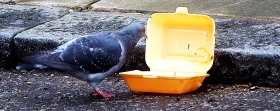Adam Yamey's Blog: YAMEY, page 139
January 6, 2022
History surveyed from a hilltop
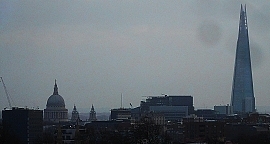
IT IS A SURPRISINGLY tiring climb to reach the summit of Primrose Hil, just north of London’s Regents Park. Yet, it is well worth making your way to the top, which is 210 feet above sea level and considerably high than much of the rest of London.
From its lofty peak, you get to see a wonderful panorama of central London and its environs. One thing struck me as I stood on the hill on New Years Day 2022. In one field of vision, without moving my eyes, I saw both St Pauls Cathedral and the Shard that stands next to London Bridge station. The former was consecrated in 1697 and the latter, the glass clad Shard was completed in 2013. Thus, in one view, I was able to see just over 300 years of history. And with all of the construction cranes that can be seen from aloft, it seems that history continues to be made, for better or for worse.
January 5, 2022
Time stands still
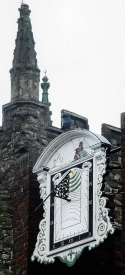 Isleworth church
Isleworth churchIt makes me wryly smile
Looking upon a sundial
For, if clouds the sky fill
Then time must stand still
January 4, 2022
A long way from Wales
Primrose Hill is south of Hampstead village and southeast of Swiss Cottage. It is a delightful place to take exercise and has been home to several notable figures. From its summit at 210 feet above sea-level, it is possible to enjoy a superb panorama of London when weather permits. At its summit, a low concrete construction is inscribed with some words by the poet William Blake (1757-1827).
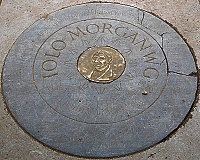
In the centre of the circular concrete platform at the summit of the hill, there is a round commemorative metal plaque surrounded with words in the Welsh language. It was placed to remember Iolo Morganwg (1747-1826), who was born in Wales as ‘Edward Williams’. He was a poet and antiquarian, who both wrote and collected poetry in the Welsh language. He had a great interest in preserving the literary and cultural heritage of his native land. His integrity as a scholar was somewhat undermined by the fact that he had forged several manuscripts that he claimed were of mediaeval origin. Nevertheless, he was involved in the early revival of Druidism. In 1792, he founded the ‘Gorsedd Beirdd Ynys Prydain’ (Gorsedd of Bards of the Island of Britain). The Gorsedd, which still meets today, is a society of poets, writers, musicians, artists, and other individuals, who have made notable contributions to the Welsh nation, language and culture. Every year, the Gorsedd assembles at a festival of Welsh culture, now known as the Eisteddfod. According to the website of the Royal Parks, Primrose Hill was the site of the first ever Gorsedd, which was held on midsummer’s day, 21 June, 1792, a long way from Wales.
January 3, 2022
Art deco discovered
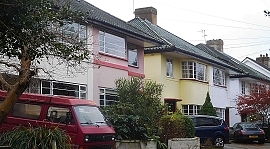
BOMBAY IS RICH in fine examples of buildings in the art deco style, which flourished roughly between the end of WW1 and the end of the 1930s. There is a good collection of buildings in this style along Marine Drive in Bombay, the Oval Maidan, and elsewhere in the city. London has some fine examples of structures that exhibit features of this kind of decorative style, but, apart from along a stretch of the A4 road, there are few concentrations of art deco buildings in London, such as can be found in Bombay. In London, the art deco buildings are mostly scattered around the city.
At the end of December 2021, we were walking with friends along the bank of the Thames between the London Apprentice pub at Isleworth and Richmond Bridge when I spotted a row of houses built in the art deco style. I had never seen them before. They line the south side of Park House Gardens in Twickenham. The detached house nearest the river, number 66, is larger and more attractive than the others in the street. The rest of the art deco residences on the street are rather mundane pairs of semi-detached homes, constructed to a pattern that I have seen elsewhere in London’s suburbs. Most of them have curved art deco period Crittall windows, which have panes of glass framed in metal rather than wood.
Park House Gardens was laid out in the early 1930s when:
“…gravel pits were filled in with, according to the local people, rubble and other material from the foundations of the Old Hotel Cecil in the Strand. The first houses were then built in Park House Gardens at prices of up to £1600 for semi-detached with garages, about the price of a garage today.” (www.twickenhampark.co.uk/a-brief-history.html)
The Cecil Hotel was in the Strand. Of its many guests, one was Mahatma Gandhi.
Another source (https://haveyoursay.citizenspace.com/richmondce/easttwickenham-spd/supporting_documents/East%20Twickenham%20SPD_Oct%2015.pdf) dates the houses differently:
“The buildings are semi-detached with Art Deco details though they do not appear to have been built until c. 1950s.”
Apart from the above information, I have found nothing else about these art deco style houses and would love to learn more.
January 2, 2022
Hung above the river
January 1, 2022
Ten instead of twelve
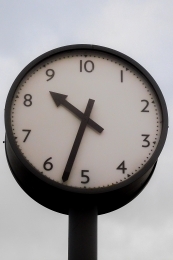
HAPPY NEW YEAR!
AT FIRST SIGHT, this clock, on the esplanade overlooking the seashore at Folkestone in Kent, looks unexceptional. But look again, and you will see that it is missing the figures ’11’ and ’12’. It is a decimal clock forming part of an artwork.
There are as you know 24 hours in a day and of these twelve are usually displayed on a clock face. For a few years during the French Revolution, it was decided to divide the day into ten hours instead of the usual 24. This was not all: the decimal hour was divided into 100 decimal minutes, each of which consisted of 100 decimal seconds. Midnight became 0 in decimal time, and 1 in decimal time was 2.24 am in the 24 hour system, 2 occurred at 4.48 am, 3 at 7.12 am, and so on. This attempt at revolutrionising time did not last for long in France. It was abandoned in 1805.
The French were not pioneers in using decimal time. They were preceded by the Chinese, who ceased using it in favour of the 24 hour system in 1645.
The decimal clock in Folkestone is one of ten in the town, which were created by Ruth Ewan as part of an artwork named “We could have been anything that we wanted to be”. The Tate Gallery website noted: “The commission comprised ten decimal clocks of different designs installed around the seaside town of Folkestone in Kent. All the clocks were displayed publicly, some in very prominent positions such as the town hall, and others that had to be either assiduously sought out or happened upon by chance, such as those found in a pub or a local taxi. With each clock, Ewan replaced the dials and mechanism to achieve the decimal regulation of time.”
The example, which we saw near a Victorian bandstand on the Esplanade has a decimal clock on one side and a regular one on the other side.
December 31, 2021
Cleansing the sole
BOOT SCRAPERS ARE metal objects found near the front doors of houses or on the steps leading up to them. Their purpose is to provide a sharpish metal surface on which people can rub the soles of their footwear to detach mud and other dirt from them before entering the house. An article published on the 21st of August 2011 in “The Independent” related that boot scrapers became popular in cities in the late 18th, and throughout the 19th, centuries.
 Boot scrapers in Warwick
Boot scrapers in WarwickAccording to the article: “Though the ancient Romans built footpaths, only the poor walked Europe’s cities until the late 18th century when the bling classes of the time hopped off their carriages to amble the streets…The sudden popularity of walking the streets helped shape today’s cities, with footpaths, tree-lined boulevards, public parks and covered arcades built during the 19th century… The new taste for strolling also saw shoes morph from heavy high-heeled designs for indoors to softer, low-heeled, foot-fitting gear, as scientists engrossed themselves in the study of motor skills and local authorities turned to public hygiene, improving sewerage and offering public toilets. …In the first decades of the century, footpaths were lined with scrapers to wipe off the mud and excrement before going indoors. As more and more people adopted the walking habit, it became vital to clear a special space for the new pedestrian class, safe from the flying mud and bolting horses.”
Despite its humble and basic function, boot scrapers, like other items of street furniture, the coal hole covers and manhole covers, attracted the creative side of their manufacturer’s minds. The result is that boot scrapers can be found with an amazing variety of decorative features. The four examples illustrated were found outside four neighbouring houses in a street in Warwick (Warwickshire). The basic design of each of these is the same, but their appearances differ considerably,
People, less privileged than those who were accustomed to riding in carriages, walked the streets in Europe long before the end of the 18th century and before the advent of boot scrapers. Some of them wore pattens, which were wooden platforms held to footwear by straps, thereby raising the wearer’s soles above the mud and other disagreeable matter on the street.
Today, it is still worth glancing down when you are out walking even though many dog owners now retrieve their pets’ solid waste matter as soon as it appears. Other users of the pavement are less considerate, but, sadly, boot scrapers seem to be going out of fashion.
HAPPY NEW YEAR!
December 30, 2021
Almost hidden from view
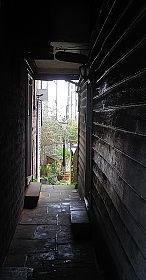
A GAP BETWEEN the houses almost opposite the long-established La Gaffe restaurant (opened in 1962) on Hampstead’s Heath Street leads into an alley lined on one side of a wall covered with overlapping planks of timber, i.e., clapboard. Steps lead down from the alleyway to a small sunken paved square surrounded by houses, some of which are 18th century. This almost hidden nook is called Stamford Close. The name derives from the now-demolished Stamford Lodge, where John Constable and his family were briefly lodgers in 1823 after they had left their rented accommodation on Hampstead’s Lower Terrace, where they lived between 1821 and 1823.
According to Christopher Wade, in the 1930s, six old cottages were condemned and the close was considered to have been:
“…a miserable dark square – a black spot.”
Today, the square is far from miserable, and many would kill to own a house there. I am not sure how practical this would be as far as shifting heavy shopping and luggage is concerned. Also, parking cars is not possible close to the houses. Despite these disadvantages, this square would be a lovely place to live.
December 29, 2021
Eat out
December 28, 2021
Marching on
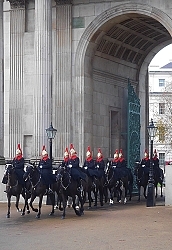
As we approach the end of the year, the pandemic rages on, the weather is appalling, and prospects for post-Brexit UK are not yet looking too bright. But all is not doom and gloom. On Christmas Eve, we went for a walk from Knightsbridge to St James Park. As we reached Hyde Park Corner and the Wellington Arch, an ever present reminder of the days when ‘England ruled the waves’ and a great deal more, we heard the sound of horse’s hooves behind us. We turned to look back at the arch and saw a line of mounted soldiers with shining helmets adorned with red tassels emerging from beneath the arch.as they have been doing several days a week for very many years, if not for several centuries. Seeing this age-old tradition being enacted in front of us reminded me that although much has been disrupted since the covid19 virus began ruling the waves, life goes on.


